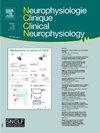Enhancing epilepsy care in Argentina: Use of SEEG in a developing setting
IF 2.4
4区 医学
Q2 CLINICAL NEUROLOGY
Neurophysiologie Clinique/Clinical Neurophysiology
Pub Date : 2025-01-23
DOI:10.1016/j.neucli.2025.103045
引用次数: 0
Abstract
Objectives
The aim of this study is to describe a population of patients with drug resistant epilepsy who underwent stereoelectroencephalography (SEEG) for epilepsy presurgical evaluation in a high complexity public hospital in Argentina.
Methods
We included patients from 2014 to 2023. We conducted a retrospective study of patients with drug-resistant epilepsy admitted to the Video-EEG unit. We selected patients who underwent SEEG and analyzed those patients in whom surgery was performed. The variables studied were MRI findings, epileptogenic zone (EZ) location, type of surgery performed, neuropsychological evaluation, post-surgical evolution and histopathology.
Results
In the study period, 49 patients underwent SEEG. Magnetic resonance imaging (MRI) was normal in 21/49 (43 %). Eighteen patients (37.5 %) had bilateral implantation, 16 (32.7 %) had unilateral right hemisphere implantation and 15 (31.3 %) unilateral left sided implantation. Surgical treatment was indicated in 30 (61,2 %) patients. Post-surgery outcome according to the International League Against Epilepsy (ILAE) classification, was ILAE I 26.6 % and ILAE II 30 %.
Conclusion
Our experience highlights that, with proper training and resource allocation, high-quality epilepsy care, including advanced diagnostic procedures like SEEG, is achievable in Argentina and may be possible in other developing regions.
加强阿根廷的癫痫护理:在发展中环境中使用SEEG。
目的:本研究的目的是描述在阿根廷一家高度复杂的公立医院接受立体脑电图(SEEG)进行癫痫术前评估的耐药癫痫患者群体。方法:纳入2014 - 2023年的患者。我们对视频脑电图单元收治的耐药癫痫患者进行了回顾性研究。我们选择了接受SEEG的患者,并分析了那些接受手术的患者。研究的变量包括MRI表现、癫痫区(EZ)位置、手术类型、神经心理评估、术后发展和组织病理学。结果:在研究期间,49例患者接受了SEEG。磁共振成像(MRI)正常者21/49(43%)。双侧种植18例(37.5%),单侧右半球种植16例(32.7%),单侧左侧种植15例(31.3%)。手术治疗30例(61.2%)。根据国际抗癫痫联盟(ILAE)的分类,术后结果为ILAE I 26.6%, ILAE II 30%。结论:我们的经验突出表明,通过适当的培训和资源分配,高质量的癫痫护理,包括SEEG等先进诊断程序,在阿根廷是可以实现的,在其他发展中地区也可能实现。
本文章由计算机程序翻译,如有差异,请以英文原文为准。
求助全文
约1分钟内获得全文
求助全文
来源期刊
CiteScore
5.20
自引率
3.30%
发文量
55
审稿时长
60 days
期刊介绍:
Neurophysiologie Clinique / Clinical Neurophysiology (NCCN) is the official organ of the French Society of Clinical Neurophysiology (SNCLF). This journal is published 6 times a year, and is aimed at an international readership, with articles written in English. These can take the form of original research papers, comprehensive review articles, viewpoints, short communications, technical notes, editorials or letters to the Editor. The theme is the neurophysiological investigation of central or peripheral nervous system or muscle in healthy humans or patients. The journal focuses on key areas of clinical neurophysiology: electro- or magneto-encephalography, evoked potentials of all modalities, electroneuromyography, sleep, pain, posture, balance, motor control, autonomic nervous system, cognition, invasive and non-invasive neuromodulation, signal processing, bio-engineering, functional imaging.

 求助内容:
求助内容: 应助结果提醒方式:
应助结果提醒方式:


